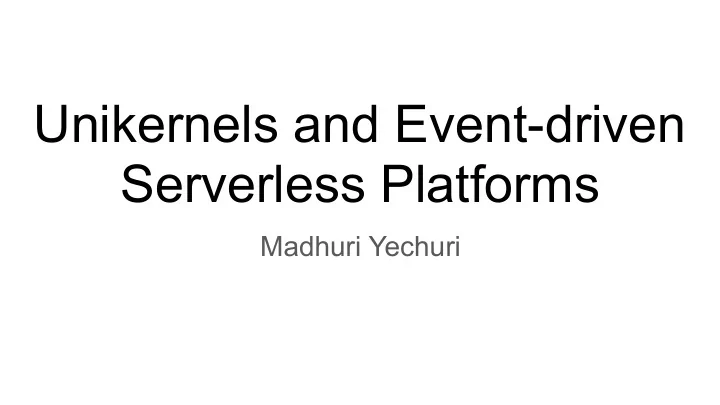

Unikernels and Event-driven Serverless Platforms Madhuri Yechuri
Agenda ● Bio ● Application Deployment Paradigms - Past, Present, Future ● Why Serverless? ● Advantages of Event-driven Serverless Model ● Event-driven application: shrink wrap needs ● Event-driven application: shrink wrap options (current) ● Unikernel definition, demo ● Event-driven application: shrink wrap options (future) ● Acknowledgements ● Q & A
Bio ● Bachelors in Computer Science (IIT Kharagpur) ● Masters in Computer Science (IU Bloomington) ● 11+ years at Oracle Database Server Technologies (RAC, TimesTen) ● 3 years at VMware (Distributed Resource Scheduler) ● 1.5 years at ClusterHQ (Flocker) ● 1 year at Elotl (stealth)
Application Deployment Paradigms - Past, Present, Future ● Past ○ (Heavyweight) Monolithic App ○ Platform: Private Cloud ○ Application Shrink Wrap: Virtual Machine ● Present ○ (Lightweight) Microservice App ○ Platform: Private Cloud, Public Cloud ○ Application Shrink Wrap: Containers ● Future ○ (Lightweight) Microservice App ○ Platform: Private Cloud, Public Cloud, IoT ○ Application Shrink Wrap: Containers, unikernels?
Why Serverless? Always-on microservices lead to - ● Always burning (cpu, memory, network) resources ○ Resources == $$$ ● Orchestration framework overhead ○ Start, health check, load balance a microservice that is only needed for “if this then that” event. ● Provisioning and Auto-scaling resource foresight ○ How many resources (cpu, memory) will each instance of my microservice need to be “happy” under peak workload? ○ How will my microservice scale with workload? ● On-disk image backing always-on microservice needs to be in-situ on every IoT Edge device
Advantages of Event-driven Serverless Model ● Reduce Operational costs == lower cloud bills ○ Use (cpu, memory, network) resources only when there is a need from application workload ● Reduce moving parts == reduce points of failure ○ Reduce orchestration framework bookkeeping when there is no client workload for the app ● Improve app performance == happier customer ○ Minimize application performance impact due to incorrect resource provisioning decisions made ahead of time ● Improve app mobility == expand into IoT markets ○ Minimize on-disk footprint of the app so that it can be easily stretched across Private/Public cloud and IoT Edge devices.
Event-driven App: Shrink Wrap Needs ● Lightweight On-disk ○ Image size should be small to allow functions to run across traditional and IoT compute nodes ■ Runtime ○ Resource (cpu, memory) overhead should be low ■ ● Agile ○ Recyclable ■ Application startup and shutdown times should be low ○ Reusable ● Secure ■ Application runtime security vulnerabilities should be minimal ● Observable Application Performance Monitoring hooks ○
Shrink-wrap evaluation - sample app Nodejs webserver: // Load the http module to create an http server. var http = require('http'); // Configure our HTTP server to respond with Hello World to all requests. var server = http.createServer(function (request, response) { response.writeHead(200, {"Content-Type": "text/plain"}); response.end(" Hello World \n"); }); // Listen on port 8002, IP defaults to 127.0.0.1 server.listen(8002); // Put a friendly message on the terminal console.log("Server running at http://127.0.0.1: 8002 /");
Event-driven App: Shrink Wrap Options (Current) App : Nodejs webserver Platform : Ubuntu 16.04 Server (Linux 4.4.0-51-generic) On-disk image Agility - Start Agility - Security APM size time Runtime vulnerabilities (MB) (seconds) Memory Overhead (MB) Container 53.48 1.13 274.4 Inherit Linux Vanilla (Amazon (Alpine 3.5 vulnerabilities CloudWatch), base) (ex: VENOM Custom attack) (IOPipes)
Event-driven App: Shrink Wrap Options (Current) AWS Lambda Google Functions Microsoft Azure IBM OpenWhisk Functions Container Container Container Container
Event-driven App: Shrink Wrap Options (Future) Are there any other shrink wrap options that meet Event-driven Application’s needs?
Unikernel - Definition ● Unikernel (working definition) ○ Single purpose (single-process) virtual appliance (multi-threading available) ○ Statically linked image of your Application and a hypervisor (no general OS or extra library code) ○ No extraneous services, no full-fledged shell, no fork() facility to start a second process
Unikernel - Demo
Event-driven App - Shrink Wrap options (future) On-disk image Agility - Start Agility - Security APM size time Runtime vulnerabilities (MB) - lower is (seconds) - Memory - Fewer is better lower is better Overhead (MB) better - lower is better Container 53.48 1.13 Inherit Linux 274.4 (126% Amazon vulnerabilities smaller) CloudWatch, (ex: VENOM IOPipes, etc attack) Unikernel 27.8 (93% 0.483 (134% 619 Minimal attack TBD smaller) faster) surface
Takeaways ● Serverless is a good fit for cost effectively running microservice applications on existing platforms (private/public cloud) ● Containers are a good fit to back serverless platforms on private/public cloud ● Unikernels exhibit promising characteristics to be a good fit for running microservice applications on existing (private/public cloud) and emerging (IoT edge) platforms.
Acknowledgements ● Emit organizers - Nick Gottlieb, Casey Shultz ● Serverless.com ● OSv ● Rean Griffith ● Audience - Thank you!
Questions? madhuri@elotl.co
Recommend
More recommend